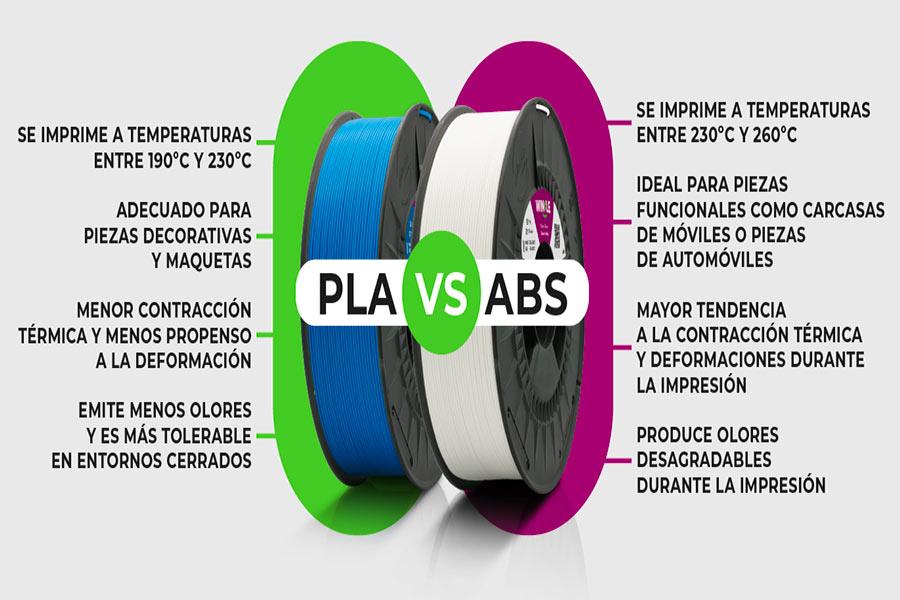Where 3D printing and injection molding intersect, the debate of "PLA vs ABS" has no end. It's a hobbyist's topic of interest, but also a life-or-death decision for product designers and engineers when choosing material forinjection molded components.
"IsABS plasticsuperior to PLA?"Such a general question is a trap in itself.The answer is neither "yes" nor "no" - there is no clear "better", but only "more appropriate" depending on particular demands.Ridiculous worrying about identifying an omnipotent winner usually causes errors in design or unnecessary costs.
ABS and PLA are analogous tools with different characteristics, each possessing unique strengths and limitations. The primary principle within the selection is to have full understanding of theirmechanical properties, thermal properties, processing characteristics, environmental impact and cost.
This article is going to break down the basicdifferences between PLA and ABSin extreme detail so that you can get past mere good vs. bad arguments. Whether you're prototyping on desktop or getting ready for massinjection-moldingmanufacturing, this tutorial will provide you with the insights to provide you with just the right fit for your next project.
PLA vs. ABS Property Comparison and Winner Analysis
| Property | PLA (polylactic acid) | ABS (acrylonitrile-butadiene-styrene) | Who is the winner? | Brief explanation |
|---|---|---|---|---|
| Print-friendliness | Very high, no warping, no heated bed required | Low, easy to warp, closed printing chamber required | PLA (for beginners) | PLA is very easy to use, has a high success rate, and requires low equipment, making it an ideal choice for beginners. |
| Strength and toughness | Hard, but brittle, easy to break | Excellent, impact-resistant, good flexibility (such as Lego blocks) | ABS (for functional parts) | ABS is far superior to PLA in withstanding impact, bending and repeated stress, and is suitable for parts that require durability. |
| Temperature resistance | Poor, starts to soften at about 60°C | Good, can withstand high temperatures of about 100°C | ABS (for high temperature environments) | ABS can withstand higher temperatures and is suitable for environments that may be heated, such as car interiors and hot water cup holders. |
| Environmental protection | Biodegradable (under industrial composting conditions) | Petroleum-based plastic, non-degradable | PLA (from the perspective of source and waste) | PLA is derived from renewable resources (corn starch, etc.), theoretically degradable (under specific conditions), and more environmentally friendly. |
| Post-processing | Difficult to polish and bond | Easy, can be polished to a mirror effect with acetone vapor | ABS (for appearance parts) | ABS is easier to polish, drill, bond, and can obtain a smooth surface through acetone polishing, suitable for display models. |
| Cost | Usually slightly cheaper | Moderate price | Tie (difference is not significant) | The two are close in price, PLA is sometimes slightly cheaper, but the price difference is usually not large and does not affect major decisions. |
| Odor and safety | There is a sweet smell when printing, which is considered safe | There is a pungent smell when printing, and good ventilation is required | PLA (for office/home environment) | PLA has a small odor and is relatively harmless, suitable for indoor environments with general ventilation conditions; ABS has a strong odor and requires strong ventilation. |
Here’s What You’ll Learn:
- A 60-second decision framework:Quickly determine whether to choose ABS or PLA for your project.
- The essential difference between the two materials:From source to characteristics, understanding the core differences can determine success or failure.
- Key performance showdown (temperature/strength/durability):Uncover the real battlefield of "Achilles' heel" and "industrial toughness".
- The gap in post-processing:Why ABS can easily achieve a "professional grade" finish, while PLA has many difficulties.
- The truth about the environmental halo:Is PLA really "greener" than ABS? Explore the not-so-complicated reality of petroleum-based and biodegradable.
- Real story from proto to production:See how a power tool enclosure for portable use cleverly usesPLA and ABSand then is forced to use injection molding.
- Practical FAQ:Clear the newbies' confusion and experts' mistakes (odor, stick, PETG substitute).
Now, let's dive into this "plastic kings" fight and find out the best material for your project!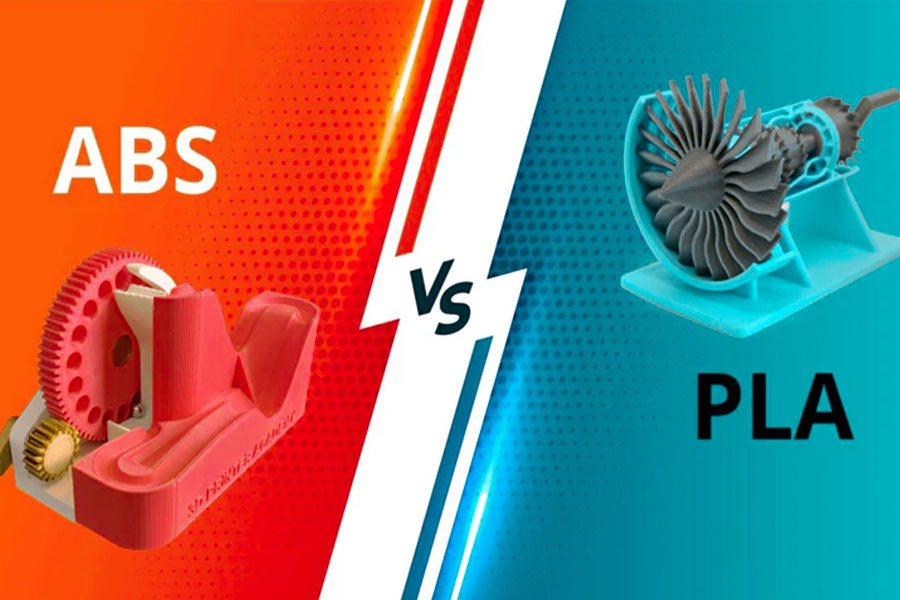
What Is PLA? The Eco-Friendly All-Rounder
1. What is PLA?
- Full name:Polylactic acid
- Essence:A thermoplastic polyester.
- Source:As you mentioned, it is primarily sourced from renewable feedstocks, such as corn starch, cassava roots, sugar cane or sugar beets. It is obtained by fermenting the plant's sugars to produce lactic acid, and polymerizing the lactic acid.
- "Bioplastic" identity:This is the core environmental claim of PLA. It is a bio-based (biomass-derived) and biodegradable/compostable plastic.
Key point:"Biodegradable" does not mean that it will easily disintegrate when discarded to the natural environment. Only in industrial composting facilities (high temperature, controlled microbial condition) can it be broken down efficiently (would take several months). Its degradation rate when composted at home or in nature is very slow, and would take a few years or longer. Don't discard it willy-nilly!
2. Why "environmentally friendly universal material" (for desktop 3D printing)? - Core benefits
(1)Easy to print:
- Low temperature of printing:Generally, it can be printed at 180°C - 220°C, and heating blocks do not have high requirements.
- No hot bed required/low temperature of the hot bed:40°C - 60°C generally, and in most cases, a hot bed can be used without it (although it performs better).
- Low shrinkage:PLA shrinks very little when cooling, greatly reducing the risk of warping and interlayer cracking, which is one of its biggest advantages over materials such as ABS, making it possible to print large, flat objects.
- Good adhesion:It usually has good adhesion on various common printing platforms (masking paper, PEI, BuildTak, glass + glue).
- Near odorless:The odor released during printing is very weak (leaning toward hot melted candy or popcorn), far less offensive thanABS materialsand perfect for use at home and in offices.
(2) Material properties (kind to beginners):
- High rigidity:Hardness of printed object is good.
- Smooth surface finish:It is easy to print models with clear details and smooth surface.
- Rich shades and varieties:There are many shades, transparencies (transparent, translucent), special effects (glitter, luminous, temperature shift, silk texture, wood/stone filling, etc.) to choose from.
(3)Relative strengths (environmental attributes):
As mentioned before, its renewable raw material origin and industrial compostability are its main environmental selling points, a desirable alternative to petroleum plastics (in respective markets).
3."Achilles' Heel" - The Biggest Weakness and Limitation
- Poor heat resistance:Glass transition temperature (Tg) is just 50-60°C. Very soft and prone to deform in the car on hot summer days or near heat sources, like "pasta".
- Brittleness:Poor impact resistance and toughness, will readily fracture.
- Limited weather resistance:Prolonged ultraviolet (UV) exposure will readily yellow and become brittle, humid climate can affect performance.
- "Degradable" misconception:Industrial composting facilities are required, and indiscriminate disposal will still cause pollution.
PLA is the undisputed leader among desktop3D printing materials. It is easy to work with, environment-friendly, and comes in a wide range of options. It is perfectly suited to low-temperature environments such as prototypes, models, and decorations. But it is definitely no panacea!Its extremely low heat resistance and brittleness make it unforgiving for applications involving heat resistance (heating components, auto components), impact resistance (buckles, tools), or extended use in the outdoors. More advanced requirements need to consider material such as PETG, ASA, and ABS.
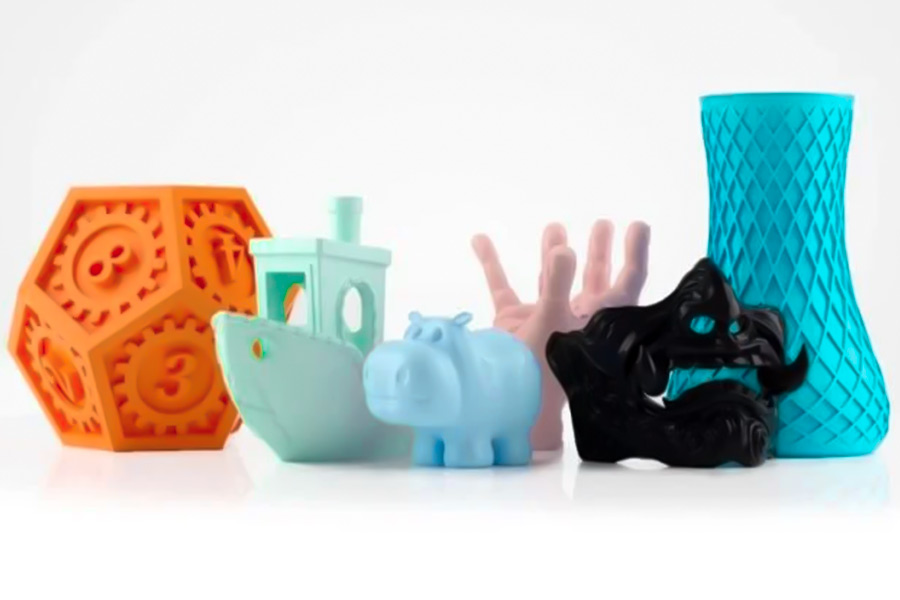
What Is ABS? The Hard, Industrial Standard
1. Source and foundation: The backbone of petroleum-based industries, same material as Lego
ABS (acrylonitrile-butadiene-styrene copolymer) is an oil-based thermoplastic, and the most commonapplication of ABSis for Lego bricks. This is solid evidence of industrial-quality ABS durability - Lego bricks maintained shape and function after decades of aggressive assembly and trampling by children, confirming the endurance of ABS in abusive applications. Its long production maturity and widespread exposure to utilization make it tried-and-true reference material in industrial manufacture.
2. Essential advantages: excellent mechanical properties, serviceable and wear-resistant
Its inherent value lies in the excellent performance of its three monomers:
- Impact resistance:elasticity imparted by butadiene content, external shock absorbing and avoiding brittle fracture;
- High temperature resistance:heat deformation temperature can reach 90–110°C (much higher than the 60°C of PLA), usable for automotive components, home appliance casings and other heat-resistant uses;
- Structural toughness:due to the high hardness and wear resistance, it is capable of supporting long-term mechanical stresses, perfect for wear components such as buckles and gears.
All the mentioned advantages make ABS not only suitable for functionalprototypeverification (e.g., assembly structure testing), but even as end-use parts, printed parts heavily used in the automotive, electronic cases, tool handles and other products.
3. The biggest challenge: the "violent" high-threshold printing process
The most painful issue of ABS for3D printingis its intense thermal shrinkage (shrinkage ratio around 0.5-0.8%):
- Warpage and delamination:anisotropic cooling shrinkage causes the edge of the part to delaminate away from the printing platform, especially for big plane parts;
- Extreme printing conditions:high-temperature environment must be supplied (nozzle 230–260°C, hot bed 100–110°C) and a closed printing cabin must be equipped to reduce temperature gradients;
- Odor and particle emission:slightly toxic volatiles are released inhigh-temperature printing, and ventilation or air-con systems are required.
These requirements significantly increase the equipment cost (constant temperature cabin required) and operation complexity (levelling, temperature control, environment control), which is well beyond the reach of beginners.
ABS is now the industry standard for producing functional components with mechanical properties no inferior to molded components and historical industrial application record. However, its printing process is more akin to "breaking a wild horse" requiring professional equipment (enclosed cabin, high temp hot bed) and refined parameter tuning to battle thermal shrinkage.Despite titanic challenges, ABS is anindustrial-grade materialthat is a necessity high-stakes applications requiring heat, impact, and structural resistances.
Strength & Durability: When Does It Really Matter?
Strength and durability are not always the main considerations when choosing materials. Their importance is rather dependent on the final product's application environment. The below table displays the employment of two common materials, PLA and ABS, under different conditions:
| Characteristics/Scenarios | PLA (polylactic acid) | ABS (acrylonitrile-butadiene-styrene) |
|---|---|---|
| Core characteristics | High hardness, good rigidity, strong detail expression, easy to print, low melting point, relatively brittle | Good toughness, strong impact resistance, high heat resistance, wear resistance, slightly difficult to print |
| Applicable scenarios | Static display models, figures, decorations, low temperature and low load parts | Functional parts, parts subjected to impact/stress, parts in high temperature environments |
| Not applicable scenarios | Force/impact environment, high temperature environment | Extreme pursuit of surface fineness (slightly inferior to PLA) |
- Display models/figures:Here, the demands of strength and durability are low. The primary demands are that the material can express the details (PLA can do this) and maintain a stable form (PLA possessessufficient hardness). Models are generally in a stable, controlled situation and are not subject to impact or high temperature. PLA's hardness and expression of fine detail exactly meet the demands, and its relative brittleness drawback isn't relevant here.
- Drone gears/arms:This is a typical usage where toughness and strength are of concern. These parts undergo torque and vibration during flight, and must absorb copious impact energy during crash. The brittleness of PLA makes it highly vulnerable to fracture ("smash into pieces") under impact. But the questionably high toughness, impact strength and limited wear resistance of ABS cause the parts to bend and deform and absorb energy instead of shattering instantly upon impact, which greatly improves the reliability of the parts and survivability of the drone.
- Mobile phone holder:This is dependent on the usage conditions.
- Normal room/desktop usage:PLA strengthand hardness are sufficient to support the weight of the phone. Now, its toughness and strength are sufficient and suitable and fit the requirements and are an economical and viable solution.
- Car dashboard usage:Temperature is the main concern. In summer, the interior temperature of the car will be well over 60°C or even 70°C, way above the glass transition temperature of PLA (approximately 55-60°C). PLA, in this case, will soften and severely deform, loose its structural support, and the strength durability along with shape retention will be lost. Heat resistant ABS higher than that (its glass transition temperature around 105°C) has to be used to impart the necessary structural strength along with shape stability under high temperature conditions.
How important the strength and durability of the material will be will depend on whether the product will be exposed to impact, stress, friction and wear or to heat conditions; in static displays or temperate conditions, other considerations (such as detail and usability) may become more important.
The Temperature Question: Going Beyond The Print Bed
Glass transition temperature (Tg) is a inherent thermodynamic polymer characteristic, such as thermoplastics that are normally used in 3D printing. Tg refers to the temperature at which a material changes from hard and brittle (glassy state) to being highly elastic (rubbery, soft and flexible).
| Application scenario | Typical temperature range (°C) | Problems with PLA | Recommended alternative materials (Tg range °C) |
|---|---|---|---|
| Coffee cup lid | Hot beverage contact: 70-90 | Softening, deformation, and seal failure when in contact with hot beverages | PETG (~80), ASA (95-100) |
| Automotive interior parts | Under exposure: >70 (up to 80+) | Softening, deformation, and loss of structural integrity in sunlight | ASA (95-100), ABS (~105) |
| Dishwasher parts | Washing/drying: 60-80+ | Hot water rinsing and heating drying cause deformation and failure | PETG (~80), ASA (95-100) |
| Material property comparison | PLA (Tg ~60°C) | PETG (Tg ~80°C), ASA (Tg 95-100°C) |
1. Glass transition temperature (Tg)
(1) Melting pointless:Tg is different from the melting point (Tm). Melting point only occurs in crystalline or semi-crystalline polymers and is a temperature at which the crystal structure is fully lost; Tg is a characteristic of all amorphous polymers or amorphous domains in polymers.Printing materialssuch as PLA and ABS all possess large amorphous domains.
(2) Molecular motion:Below the temperature of Tg, the segments of the polymer molecular chain are frozen, their mobility is restricted, and the material is hard; above Tg, the molecular chain segments gain energy and can move, and the material becomes soft and elastic (the elastic modulus drops steeply).
(3) Performance inflection point:Tg is the temperature at which the physical properties of the material, such as hardness and stiffness, change noticeably. For structural application, the material needs to be significantly below its Tg in the highest operating temperature to maintain shape and function.
2. Why not rule out PLA?
PLA's low Tg (~60°C) renders it highly susceptible to failure in hot environments:
- Coffee cup lid:Hot drinks (70-90°C) will warp and distort PLA lid, affecting sealing and usability.
- Automotive interior parts:Vehicles' interior temperatures above 70°C due to sunlight exposure soften PLA parts and warp, affecting structure and safety.
- Dishwasher parts:Drying and hot water wash (60-80°C+) makePLA partscreep, warp, and fail.
3. Heat-resistant substitutes: PETG and ASA
- PETG (Tg ~80°C):Substantially more heat-resistant than PLA, with benefits including easy printing, transparency and strength, and chemical resistance (especially water/weak acid and alkali). Suitable for medium heat-resistant uses such as cup lids and dishwasher middle brackets, though it can creep under sustained high heat and possesses moderate outdoor weather resistance.
- ASA (Tg 95-100°C):Literally an "improved variant" of ABS. Maintaining its toughness and strength like ABS, its heat resistance (anti-UV) and weather resistance are dramatically improved. It is the ideal choice for automotive interior and exterior, long-term outdoor parts and applications with more stringent demands for heat resistance. Heating bed and anti-warping conditions are required to print.
The fundamental of material selection is to ensure that its glass transition temperature (Tg) is considerably higher than the highest level of the working temperature. It is an iron rule to ensure the structure integrity of parts under high temperature.
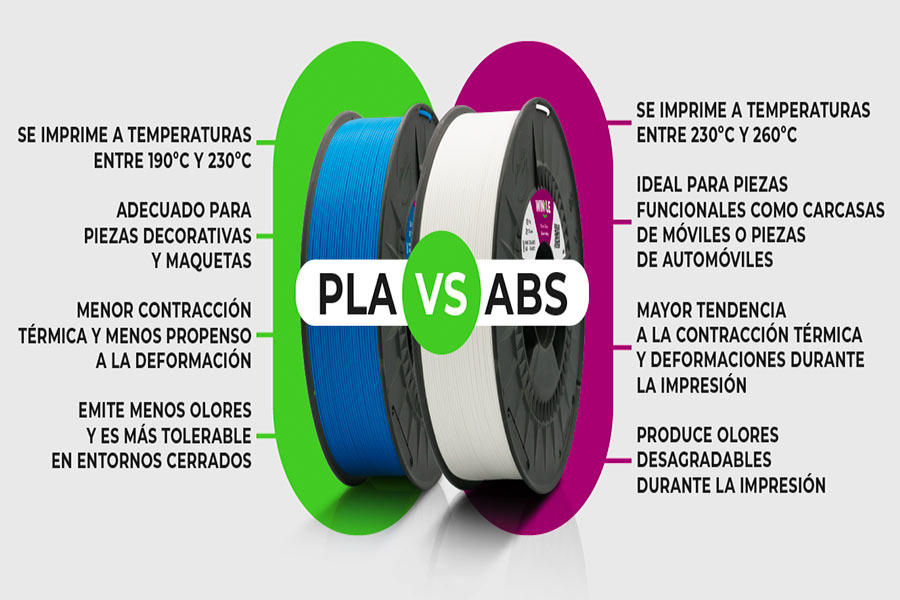
Post-Processing: The Route To A Professional Finish
| Features | ABS | PLA |
|---|---|---|
| Top Surface Finish | Acetone Vapor Polishing: High gloss, injection-molding-like finish | Sanding is difficult, prone to burrs; cannot be chemically polished to the same finish |
| Bondability | Relatively easy, many solvent glues (such as acetone-based) work well | More difficult, requires specialty glues (such as cyanoacrylate) or special treatments |
| Professional Prototype Suitability | Very high: Ideal for consumer prototypes that require a smooth, high-quality appearance | Medium: Better suited for functional prototypes or parts that do not require high appearance |
1. ABS's trump card:
- Acetone steam polishing:Basic advantage. The surface layer is dissolved and hardened with steam to create a high-gloss, injection-like smoothness.
- Visual impact:The contrast of polishedABS partswith normal PLA parts has an enormous difference in impact and rich texture.
- Key applications:It is essential for consumer product prototypes that need to show the texture of the final product, greatly adding to the impression of professionalism.
2. Weakness of PLA:
- Difficult polishing:It's a brittle material, prone to burrs or brushing, and difficult to polish smoothly to the required smoothness.
- Bonding issues:Regular solvent glue does not work, and one has to use special glue (such as super glue) or special treatment, which is more complicated and costly.
- Limitations of surface treatment:Although there are improvements such aspolishingand painting, it is far less convenient and effective than ABS acetone polishing, and it is difficult to achieve the same top finish.
In the world of consumer product prototypes that aim for professional-gradesurface finish, ABS, with its special acetone vapor polishing, is much superior to PLA, which suffers the double disadvantages of sanding and gluing.
The "Eco-Friendly" Debate: Is PLA Really Green?
| Features | PLA (polylactic acid) | ABS (acrylonitrile-butadiene-styrene copolymer) |
|---|---|---|
| Source of raw materials | Plant-based (such as corn starch, sugar cane) | Petroleum-based |
| Degradability | Theoretically biodegradable | Non-degradable |
| Degradation conditions | Requires specific industrial composting facilities (high temperature and high humidity) | - |
| Degradation in natural environment/landfill | Extremely slow (similar to traditional plastics) | Extremely slow/non-degradable |
| Recyclability | Theoretically recyclable, but sorting is difficult and the recycling system is immature | Recyclable and reused (need to improve the recycling system) |
| Product life | Relatively short (susceptible to heat/humidity) | Very durable (meaning longer service life) |
1. PLA: Fact
It is plant-based material (corn), and in theory, it is more environmentally friendly.
But "biodegradable" does require high-humidity, high-temperature industrial composting plants (microorganisms). It degrades extremely slowly in the natural or landfill settings, almost as slowly as conventional plastics.
Not readily recyclable (not readily sorted, no outlets).
2. ABS: Reality
Raw materials are petroleum-based, and production energy consumption and carbon emission are high.
Advantages are recyclability (relatively mature technology) and durability (extension of product life), and effective recycling is able to reduce environmental impact.
3. The complexity of environmental protection:
PLA has a better starting point (raw materials), but the terminal point (processing) is heavily dependent upon scarce composting facilities, and the net advantages are limited.
ABS has a heavy initial weight, but recyclability is a big compensation, and its performance depends upon efficiency in recycling and duration of use.
They both are plagued with the issue of wastemanagement, and without the corresponding infrastructure (composting/recycling), they contribute to long-term environmental degradation.
The environmental benignity of PLA and ABS is far more than a "green" label. The true environmental impact of both is more nuanced than advertised and heavily depends on their overall life cycle (more specifically, the waste treatment infrastructure).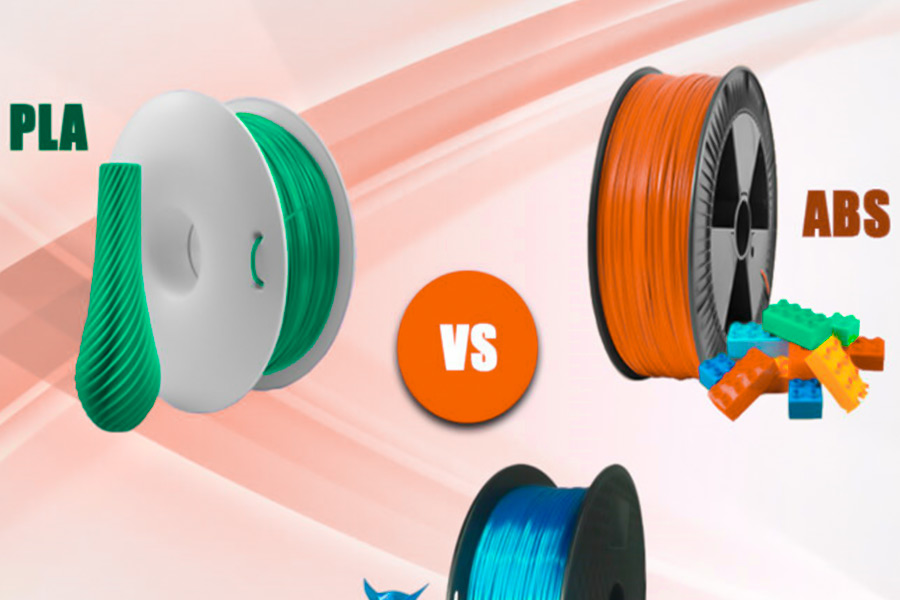
Case : Handheld power tool housing design process
In LS company's new project of developing a new housing for portable power tools, we were successful in utilizing diverse manufacturing technologies and materials:
1. Confirmation through rapid prototyping (3D printing):
(1) Purpose:Quick iteration to inspect appearance, ergonomics and basic functions.
(2) Implementation:
- Appearance/ergonomic model:PLA 3D printingis utilized. Its low cost, high speed and acceptable resolution enable us to quickly inspect the grip, button layout and make design adjustments.
- Function/test model:ABS 3D printingis used. Take advantage of its increased strength, toughness and heat resistance, and inner assembly verification and drop impact testing are conducted to ensure that the design will meet the required functions and initial durability requirements.
2. Mass production (injection molding):
(1) Target:To achieve extensive-scale, cost-effective manufacturing in a way that will end in final product performance.
(2) Material selection:Based on the result of prototype test and final application requirements (good resistance, excellent impact resistance, and good workability in outdoor/workshop temperature conditions), ABS is to be selected as the ideal mass production material.
(3) Process conversion:After the design was confirmed and the production demand became apparent, we decided to convert from 3D printing to injection molding. Through taking professional onlineinjection molding services, we optimized mold investment and single-piece injection molding cost successfully.
3. LS's professional value:
This case is about the right comprehension of the material properties and the process conversion timing:
- PLA and ABS both play their part in the prototyping stage (PLA is form-conscious, ABS is function-conscious), and neither is indispensable.
- From the ABS prototype test data, we are confident that it can meet the mass production requirement.
The main challenge is knowing when to shift from fastprototypingto bulk manufacturing and determine the most cost-effective path (e.g., online injection molding service). LS's background guarantees that the shift to manufacturing via injection molding occurs at the right node, reducing unit cost significantly while allowing for streamlined product launch.
This reflects LS's broad capability in material utilization, prototype manufacturing and mass manufacturing planning.
FAQs
1. What material can I buy for my first 3D printer?
In the case of beginners' first3D printer, it is highly recommended to start with PLA material, as PLA is easy to print, low warping, non-toxic, and has a light odor, hence making PLA a good material to understand fundamental features such as bed leveling and temperature control. It is cheap, environmentally friendly, and can help you learn fast. Master it, and then play with progressively tougher materials to avoid frustration in the early stages and have a print success rate of over 90%. In short, PLA is where a beginner should start and then later explore other options.
2. Is ABS printing smell toxic?
Yes, ABS will release volatile organic compounds (VOCs) such as styrene when printed, and these have health risks in long- or high-concentration exposure, such as respiratory irritation or the potential for toxicity. Although concentrations in home printing tend to be low, it is strongly recommended to print in a well-ventilated space or with an enclosed printer that features a HEPA filtration system in an effort to reduce the potential for inhalation. Having windows open on a regular basis or using exhaust fans is a good way to reduce risks, ensure safe printing, and avoid extensive working in tight spaces.
3. And PETG? Is there some middle ground?
PETG is a decent middle ground between PLA and ABS: stronger and heat resistant than PLA (can tolerate temperatures over 80°C), but easier to print with less warping than ABS. Nonetheless, it is not an ideal match, since PETG has major drawbacks, including strong water absorption (must be stored in dry conditions to avoid loss of performance) and stringing (must fiddle with the printer retraction settings). Generally speaking, PETG is appropriate for situations that need to be strong and user-friendly but must be handled within its limitations by its users in order to maximize its benefits.
4. How do I bond PLA and ABS parts together?
To bond PLA parts, we suggest using cyanoacrylate glue (i.e. super glue), which creates a very strong bond very quickly. For ABS parts, acetone-based glue or pure acetone is used, which melts by chemically degrading the surface, creating an extremely strong bond. Also note that different materials need to be treated in different ways: PLA is acetone-insensitive, but ABS requires short pressure on joining to have the effect. For hybrid bonding, epoxy adhesives may work, but ensure compatibility to avoid failure.
Summary
PLA is a docile "beginner" and "demonstrator", while ABS is a tough "worker" and "doer".
There is no absolute "better", there is simply more "appropriate" for your project needs. The choice between PLA or ABS depends on your application environment - are you seeking the convenience and looks of printing, or do you need the ruggedness and environmental robustness of the part? Consider the actual requirements to determine an actual corresponding material solution.
Choosing between PLA and ABS is just the tip of the iceberg in your manufacturing process. As your project moves from one prototype to production, the real challenge then is actually how effectively and with quality you can do it.Upload your designto our secure platform today, and not only will you get an instant 3D printing orinjection molding quote, but also valuable advice from product manufacturing experts at every stage of the product life cycle! Let the right material and processes lead you to success.
📞Tel: +86 185 6675 9667
📧Email: info@longshengmfg.com
🌐Website:https://lsrpf.com/
Disclaimer
The contents of this page are for informational purposes only.LS seriesThere are no representations or warranties, express or implied, as to the accuracy, completeness or validity of the information. It should not be inferred that a third-party supplier or manufacturer will provide performance parameters, geometric tolerances, specific design characteristics, material quality and type or workmanship through the LS network. It's the buyer's responsibilityRequire parts quotationIdentify specific requirements for these sections.Please contact us for more information.
LS Team
LS is an industry-leading companyFocus on custom manufacturing solutions. We have over 20 years of experience with over 5,000 customers, and we focus on high precisionCNC machining,Sheet metal manufacturing,3D printing,Injection molding,Metal stamping,and other one-stop manufacturing services.
Our factory is equipped with over 100 state-of-the-art 5-axis machining centers, ISO 9001:2015 certified. We provide fast, efficient and high-quality manufacturing solutions to customers in more than 150 countries around the world. Whether it is small volume production or large-scale customization, we can meet your needs with the fastest delivery within 24 hours. chooseLS technologyThis means selection efficiency, quality and professionalism.
To learn more, visit our website:www.lsrpf.com


